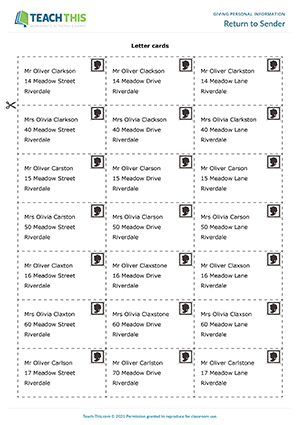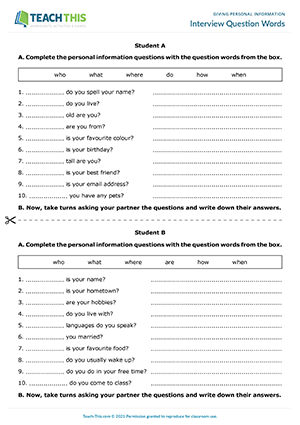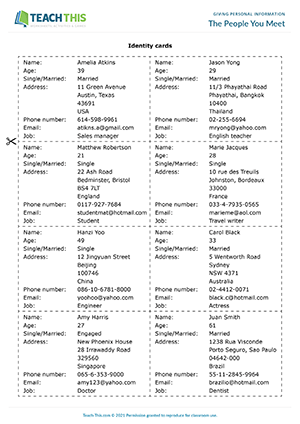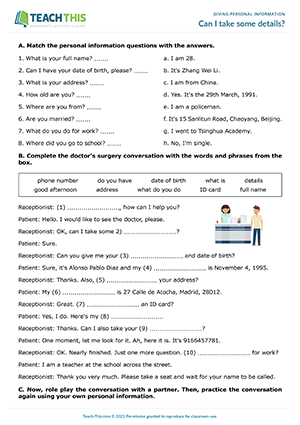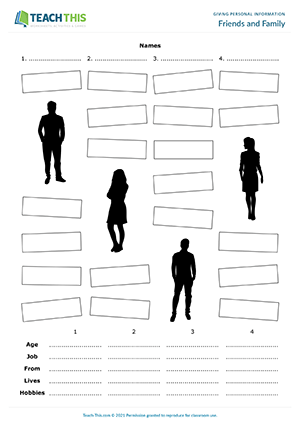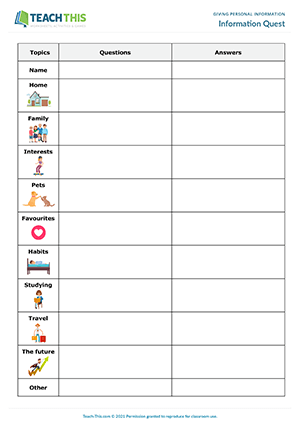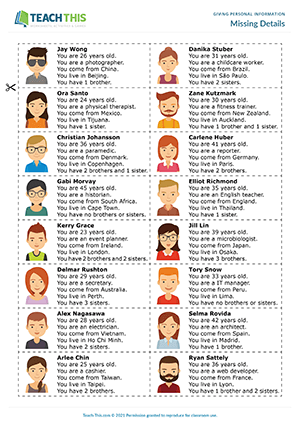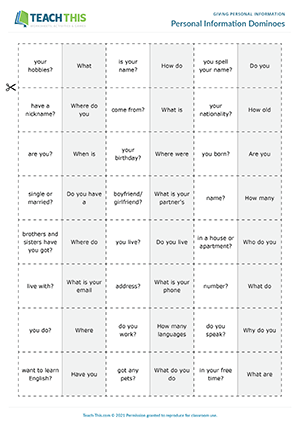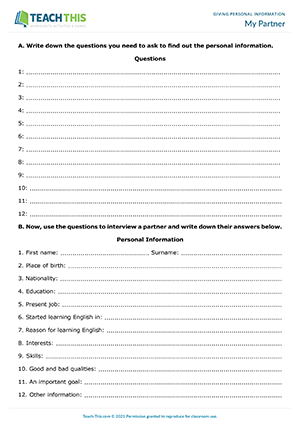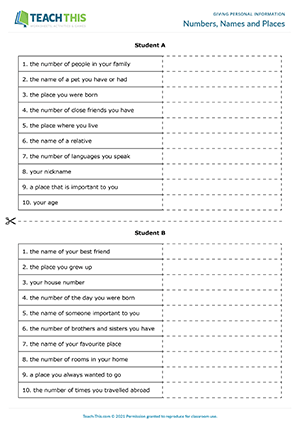Here is a useful giving basic personal information speaking activity to help beginners practice asking and answering personal information questions about names and addresses. The students in one group each have an identity card, showing their name and address. The students in the other group are postal workers and each have a letter card. Their task is to deliver their letter to the name and address written on their card. All the names and addresses are very similar so the postal workers need to listen and check the information carefully. The postal workers go around the class asking for the names and addresses of the other students until they find the person with a matching name and address. When this happens, the postal worker gives the student the letter. When all the postal workers have delivered their letters, students swap roles and repeat the activity.
In this engaging personal information questions speaking activity, students complete personal information questions with question words and use them to interview a partner. This activity can be used on the first day of class to help students get to know each other. In two groups, students complete personal information questions with question words from a box. Next, students pair up with someone from the other group and take it in turns to ask their partner the personal information questions on their worksheet and note down their answers. Afterwards, students tell the class what they found out about their partner.
In this productive giving personal information role-play, students take on a new identity and complete a worksheet by asking and answering personal information questions. Students start by writing down the questions they need to ask to find out the personal information on the worksheet. Next, in groups, students take on the role of a person on an identity card and complete the worksheet by asking one another personal information questions. When everyone has finished, students compare identity cards and worksheets to check they have written the information correctly.
This free asking for and giving personal information worksheet helps students learn and practice ways to ask for and give personal information. First, students match personal information questions with suitable answers. Students then use words from a box to complete a gap-fill exercise about a conversation at a doctor's surgery where a receptionist is asking a patient for personal information. After that, students role-play the conversation with a partner and then practice the conversation again using their own personal information. Next, students answer comprehension questions about the conversation at the doctor's surgery. In the last exercise, students write one question to ask about each piece of personal information listed and then ask and answer the questions with a partner.
In this handy yes/no personal information questions speaking activity, students ask and answer questions about friends and family. To start, students think of four friends or family members, two males and two females, and write the people's names on the worksheet next to numbers. Students then write the age of each person, their job, where they are from, where they live and their hobbies in a random order in boxes on the worksheet. Next, students swap worksheets with a partner and take it in turns to ask and answer yes/no personal information questions in order to complete the details for each person at the bottom of the worksheet, e.g. 'Is Isabella 26 years old?' Students continue asking and answering questions until all the personal information has been completed. Afterwards, students tell the class about one of their partner's friends or family members.
Here is a creative giving personal information speaking activity to use on the first day of class. In the activity, students create personal information questions, ask them to a new classmate and then use the information to introduce the classmate to other students. In groups, students create personal information questions for the categories on the worksheet. Next, students pair up with someone from another group and take turns asking their partner the personal information questions, noting down their answers on the worksheet. When everyone has finished their interviews, students use the information to introduce their partner to another pair. Afterwards, pairs stand up and introduce their partner to the class. At the end of each introduction, students ask follow-up questions to the person being introduced.
In this interesting personal details speaking activity, students ask and answer basic personal information questions in order to complete a chart with personal details. Students take on the identity of the person on their card and complete their personal details in a chart. The chart also shows one piece of information for each of the other identities. Students then go around the class and complete the missing details for the other identities by asking one another personal information questions. Students begin by asking yes/no questions to find out which information in the chart corresponds to the person they are speaking with, e.g. 'Are you 26?' When a classmate replies 'yes', the student asks personal information questions to complete the other information about the person's identity. This continues until students have completed the chart.
In this fun personal information questions game, students form, ask and answer questions about personal information. The first player tries to make a personal information question by placing a domino down either before or after the domino on the table. If the player can form a grammatically correct and logical question, they ask the question to the next player. If the next player answers correctly, it is their turn to put down one of their dominoes at either end of the domino chain and ask a question to the next player. If a player fails to answer a question correctly, they miss a turn and the question passes to the next player to try to answer. The first player to get rid of all their dominoes wins the game.
In this free networking role-play activity, students practice exchanging personal and company information at a networking event. The aim of the activity is to find out about people at the event in hopes of building new business partnerships or finding new customers. To begin, students complete a gap-fill text by putting a mixture of real and imaginary information in the spaces provided. Students then use the information to socialise with the other people at the networking event. Students note down the information of three people they speak to in a chart. However, students should try to make introductions with as many people as possible and give information about themselves and their company. Afterwards, there is a class feedback session to find out if anyone found customers for their business or someone they could possibly build a business relationship with.
In this intriguing asking for and giving personal information activity, students create personal information questions and then use the questions to interview a partner. This activity is suitable for older students. Students begin by writing down the personal information questions they need to ask to find out the information at the bottom of the worksheet. Students also create one more question of their own at the end. Next, in pairs, students take it in turns to ask their partner the questions and fill in the answers on the worksheet. Afterwards, pairs of students take it in turns to tell the class a few things they found out about their partner.
In this insightful personal information speaking activity, students talk about personal information relating to numbers, names and places with a partner. First, students write down a number, name or place for each item on their worksheet. Next, students cut the worksheet into cards and give them to a partner who spreads them out on the desk face up. Next, students take it in turns to pick up a card and ask their partner about the number, name or place written on the card. Students are encouraged to ask for and give as much information as they can for each item and try to develop a short conversation about each one. Afterwards, students share what they found out about their partner with the class.
Latest Free
Resources
- Everyday Objects Bingo
Everyday Objects
Elementary (A1-A2)
- Action Verb Races
Actions
Elementary (A1-A2)
- Birthday Basics
Birthdays
Elementary (A1-A2)
- Sales Phrasal Verbs
Business Phrasal Verbs
Upper-intermediate (B2)
Latest Member
Resources
- Collocations at Work
Business Collocations
Intermediate (B1)
- Etiquette Trivia Board Game
Etiquette and Manners
Upper-intermediate (B2)
- Everyday Objects Vocabulary
Everyday Objects
Pre-intermediate (A2)
- Let's have a talk
Verb-Noun Collocations
Pre-intermediate (A2)



